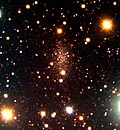| Pisces Dwarf | |
|---|---|
 Pisces I with the legacy surveys | |
| Observation data (J2000 epoch) | |
| Constellation | Pisces |
| Right ascension | 01h 03m 55.0s [1] |
| Declination | +21° 53′ 06″ [1] |
| Redshift | -287 ± 0 km/s [1] |
| Distance | 2.51 ± 0.08 Mly (769 ± 25 kpc) [2] |
| Apparent magnitude (V) | 14.2 [1] |
| Characteristics | |
| Type | dIrr/dSph [1] |
| Apparent size (V) | 2′ × 2′ [1] |
| Other designations | |
| Pisces I, Psc I, LGS 3, [1] PGC 3792, [1] LEDA 3792 | |
The Pisces Dwarf, also known as Pisces I, [1] is an irregular dwarf galaxy that is part of the Local Group. The galaxy, taking its name from the constellation Pisces where it appears, is suspected of being a satellite galaxy of the Triangulum Galaxy (M33). It displays a blueshift, as it is approaching the Milky Way at 287 km/s. It may be transition-type galaxy, somewhere between dwarf spheroidal and dwarf irregular. Alternatively, it may be a rare, but statistically acceptable, version of one of the two types. [2]


